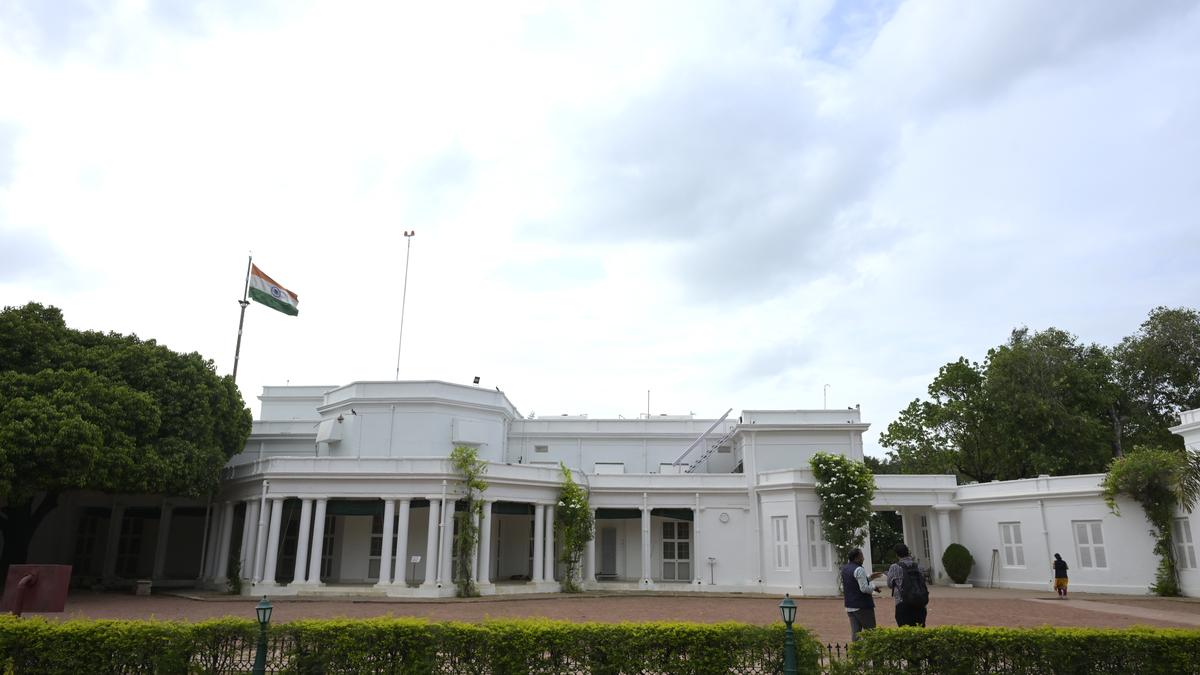
A step into history, Rashtrapathi Nilayam offers a glimpse into heritage and fauna Premium
The Hindu
Explore the historic Rashtrapati Nilayam in Secunderabad, India, with Cheriyal art, lush gardens, and rich heritage.
The underground curved tunnel connecting the kitchen and the secretariat building inside the Rashtrapati Nilayam, the official residence of President of India during the Southern Sojourn, was built to ensure that the food being taken from the kitchen could not be poisoned, when the building was occupied by the Britishers during the 1800s. At least that’s what the staffers of the place say. Another reason was said to be that the Britishers did not want their butlers to be seen walking around the place. Today, the tunnel, now restored and open to the public, houses beautifully drawn Cheriyal art forms depicting Telangana culture. One way to tell Cheriyal art form apart is the enlarged pupils in the eyes of its characters.
Built in the 1860, the Rashtrapati Bhavan is nestled amid the Secunderabad’s cantonment area and is spread over a campus of 97 acres, including 33 acres of greenery.
Once used as the Residency House for the British government and later the abode of the Nizam’s Chief Military Officer. On September 17, 1948, the unification of the Princely State of Hyderabad with India took place here. After becoming the President’s winter retreat post Independence, Rashtrapati Nilayam was traditionally opened to the public for 15 days in January, after the President’s winter visit. In the March of 2023, President Droupadi Murmu opened up the place to the public all-year round.
The main building, the residence used by the President during their visit in the winters, showcases architectural prowess with 16 rooms, including the President’s study, private apartments, dining hall, cinema hall, and durbar hall. The furniture inside the durbar hall is retained since the first President’s stay, while the chandeliers are from Nizam’s period and the antiques on display are from the British era.
Behind the main building there is a Japanese pagoda tree (styphnolobium japonicum), which provides shade for a small bench. Opposite to that is a fruit garden, kept intact from Abdul Kalam’s regime and has all the seasonal fruits. A visitor touring the vast premises can hear peacocks and even see a few of them.
The front of the building has the unmissable, majestic 120 feet replica of one-of-its-kind teakwood flag post symbolising the unification of Hyderabad with India. The pole is put together with three wooden pieces, including two 50-feet logs and one 20 feet.
One can also witness the displays of traditional water management through the revival of three stepwells, with the Jai Hind Stepwell featuring an engaging live demonstration of the age-old bullock-driven water drawing system.

After a long, tiring day all we want is to jump right on our cosy beds and rest comfortably on our soft, fluffy pillows, right? Pillows are not quite appreciated as much as electric cars or air-fryers, for instance. Pillows are a wonderful man-made creation that has improved the lives and sleep of people across the globe. Did you know ages ago people used to rest their heads on a HARD ROCK? So how did humans go from sleeping on stones to cosy, fluffy and soft pillows today? Let’s get into the origin of your everyday pillows!

As the November 30 deadline nears for installing vehicle location tracking devices (VLTD) and emergency panic buttons in public service and nationally permitted goods vehicles in Karnataka, transport unions representing cab, bus, and truck operators are urging the government to reconsider the mandate. They argue that the high cost of these devices and a lack of awareness have made it difficult for many vehicle owners to comply with the requirement.









